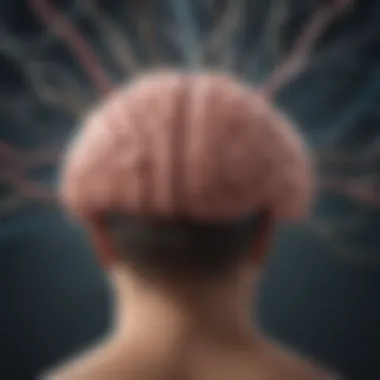Unraveling the Complexities of Hyper Anxiety Disorder: Symptoms, Causes, and Treatments


Research Overview
Upon venturing into the realm of hyper-anxiety disorder, it becomes imperative to grasp the fundamental intricacies that underlie this mental health condition. Research has unearthed a myriad of insights delving into the symptoms, causes, and treatment options available for individuals grappling with this challenge. The existing literature provides a mosaic of findings, offering a nuanced perspective on the phenomena associated with hyper-anxiety disorder. Methodologies applied in these studies range from clinical observations to neuroimaging techniques, shedding light on the underlying mechanisms triggering intense anxiety in affected individuals.
Health Implications
The revelations from research on hyper-anxiety disorder have profound implications for health outcomes. By dissecting the impact of this disorder on individuals' well-being, researchers have identified potential benefits and risks associated with different treatment modalities. Understanding these implications can pave the way for tailored interventions that target the root causes of hyper-anxiety, ultimately enhancing mental health outcomes. Through practical examples of how research findings can be integrated into daily life, individuals can empower themselves to navigate the challenges posed by hyper-anxiety in a more informed manner.
Well-being Strategies
Derived from empirical research, a repertoire of well-being strategies emerges to assist individuals in managing hyper-anxiety disorder effectively. These pragmatic tips delve into actionable steps that can be implemented in daily routines to foster positive mental health outcomes. By intertwining evidence-based practices with real-life applications, individuals can unleash the potential for gradual improvement and symptom management. Personal narratives and case studies further amplify the efficacy of these strategies, elucidating the transformative impact they can have on enhancing overall well-being.
Expert Insights
An in-depth analysis of expert opinions offers a panoramic view of the research findings, delving into the nuances of hyper-anxiety disorder from various perspectives. Experts in the field provide valuable insights into the implications of research outcomes and offer potential avenues for further exploration. Engaging in a thoughtful Q&A session with a relevant expert illuminates lesser-known aspects of hyper-anxiety disorder, unraveling its complexities and implications in a digestible format for readers seeking a deeper understanding of this mental health condition.
Introduction to Hyper Anxiety Disorder
In delving into the realm of hyper anxiety disorder, one must first comprehend the profound impact it has on individuals' mental well-being. It serves as a crucial topic within the framework of mental health discussions, shedding light on lesser-known aspects of anxiety disorders. By dissecting the intricacies of hyper anxiety disorder, we aim to provide readers with evidence-based insights and practical advice, offering a comprehensive understanding. This article seeks to emphasize the importance of recognizing and addressing hyper anxiety disorder for a more informed and compassionate approach towards mental health.
Defining Hyper Anxiety Disorder
Characteristics of Hyper Anxiety
When exploring the characteristics of hyper anxiety, it becomes evident that the intensity and frequency of anxious thoughts and feelings differ significantly from other forms of anxiety disorders. Individuals grappling with hyper anxiety may experience heightened levels of apprehension and unease, often leading to persistent overthinking and irrational fears. The distinctive feature of hyper anxiety lies in its relentless grip on individuals, impacting various facets of their daily lives. Understanding these specific characteristics is paramount in distinguishing hyper anxiety from more generalized forms of anxiety, allowing for tailored interventions and support strategies to be implemented effectively.
Distinguishing Hyper Anxiety from General Anxiety
Setting hyper anxiety apart from general anxiety necessitates a nuanced understanding of their nuanced differences. While general anxiety encompasses a broader spectrum of worries and concerns, hyper anxiety manifests as an intensified version characterized by overwhelming panic and a pervasive sense of dread. The key distinguishing factor between these two lies in the acute and debilitating nature of hyper anxiety, which often necessitates specialized treatment approaches. By elucidating these disparities, we aim to provide clarity on the unique challenges posed by hyper anxiety and the significance of tailored interventions to address its specific nuances.
Prevalence and Impact
Global Statistics on Hyper Anxiety
Navigating the global landscape of hyper anxiety statistics unveils the staggering prevalence of this mental health condition across diverse populations. The statistical data highlights the alarming rise in reported cases of hyper anxiety, emphasizing the pressing need for increased awareness and access to mental health resources. By scrutinizing these statistics, we can grasp the far-reaching impact of hyper anxiety on individuals worldwide, prompting a call to action for more robust support systems and intervention strategies.
Impact on Daily Life and Relationships
The repercussions of hyper anxiety extend far beyond the individual, reverberating throughout their daily interactions and relationships. This section delves into the profound impact of hyper anxiety on various aspects of daily life, such as work performance, social interactions, and familial relationships. By illuminating the detrimental effects of hyper anxiety on personal well-being and interpersonal dynamics, we underscore the urgency of fostering a supportive environment that encourages empathy, understanding, and holistic wellness.
Understanding the Root Causes


Genetic Predispositions
Exploring the role of genetic predispositions in contributing to hyper anxiety illuminates the intricate interplay between genetic factors and mental health outcomes. By unraveling the genetic markers associated with hyper anxiety, researchers gain valuable insights into potential risk factors and hereditary influences shaping individuals' susceptibility to this disorder. Understanding the genetic underpinnings of hyper anxiety opens new avenues for personalized interventions and preventive measures, enhancing our capacity to address mental health challenges from a multifaceted perspective.
Environmental Triggers
Unpacking the impact of environmental triggers on hyper anxiety underscores the significance of external factors in exacerbating or mitigating symptoms. Environmental stimuli, such as traumatic experiences, chronic stressors, or significant life events, can significantly influence the onset and progression of hyper anxiety. By scrutinizing these triggers, we glean a deeper understanding of the environmental contexts that contribute to individuals' mental health struggles, paving the way for targeted interventions and holistic treatment approaches tailored to address both internal and external stressors.
Symptoms and Diagnostic Criteria
In the realm of hyper anxiety disorder, understanding the symptoms and diagnostic criteria plays a pivotal role in identifying and addressing this mental health condition. Symptoms serve as key indicators for healthcare professionals to make an accurate diagnosis and develop targeted treatment plans. They encompass physical manifestations, emotional and cognitive symptoms, and specific diagnostic criteria. Each aspect offers valuable insights into the complexities of hyper anxiety, shedding light on how individuals experience and cope with this disorder.
Physical Manifestations
Palpitations and Shortness of Breath
When delving into the physical manifestations of hyper anxiety disorder, palpitations and shortness of breath stand out as hallmark signs that can significantly impact an individual's quality of life. Palpitations, characterized by irregular or rapid heartbeat sensations, are often accompanied by shortness of breath, creating a sense of impending doom or panic. These symptoms can escalate during anxiety-provoking situations, leading to heightened distress and discomfort. Despite their distressing nature, palpitations and shortness of breath offer valuable diagnostic clues for healthcare providers, aiding in the accurate assessment and management of hyper anxiety.
Muscle Tension and Fatigue
Muscle tension and fatigue represent common physical symptoms experienced by individuals grappling with hyper anxiety disorder. The persistent tensing of muscles, often accompanied by a sense of heaviness and exhaustion, can contribute to feelings of discomfort and restlessness. This physical manifestation is closely intertwined with the emotional distress associated with hyper anxiety, as heightened arousal levels can exacerbate muscle tension and fatigue. By recognizing and addressing these symptoms proactively, healthcare professionals can tailor interventions that alleviate physical strain and enhance overall well-being for individuals dealing with hyper anxiety.
Emotional and Cognitive Symptoms
Irrational Fears and Worries
Emotional and cognitive symptoms such as irrational fears and worries are prevalent among individuals with hyper anxiety disorder. These symptoms manifest as exaggerated apprehensions and irrational beliefs, often disproportionate to actual threats. The pervasive nature of these fears can fuel a constant state of unease and uncertainty, significantly impacting one's emotional well-being. Understanding the underlying mechanisms driving these irrational thoughts is essential for comprehensive treatment planning and targeted therapeutic interventions aimed at challenging maladaptive patterns of thinking.
Difficulty Concentrating
Difficulty concentrating is another hallmark symptom of hyper anxiety disorder that can hamper one's ability to focus, process information, and engage in daily tasks effectively. This cognitive impairment arises from the persistent intrusive thoughts and worries characteristic of hyper anxiety, creating a cognitive overload that impedes concentration and decision-making. By acknowledging and addressing issues related to attention and cognitive functioning, individuals with hyper anxiety can explore strategies to enhance concentration, productivity, and cognitive flexibility.
Diagnostic Criteria
Assessment Tools for Hyper Anxiety
Diagnostic criteria for hyper anxiety encompass specific assessment tools designed to evaluate the severity and impact of symptoms on an individual's functioning and well-being. These standardized measures assist healthcare providers in establishing an accurate diagnosis, tracking symptom progression, and tailoring personalized interventions. By utilizing evidence-based assessment tools, clinicians can gather comprehensive data to inform treatment decisions and monitor treatment outcomes effectively.
Clinical Evaluation
Clinical evaluation forms a cornerstone of the diagnostic process for hyper anxiety disorder, offering valuable insights into a patient's symptom presentation, medical history, and overall mental health status. Through a comprehensive assessment conducted by trained professionals, individuals can receive a thorough evaluation of their condition, paving the way for informed treatment planning. Clinical evaluations encompass interviews, symptom inventories, and observation measures, providing a holistic understanding of the individual's psychological profile and treatment needs. By integrating clinical evaluations into the diagnostic process, healthcare providers can ensure accurate diagnoses and tailored interventions for individuals grappling with hyper anxiety disorder.


In this section, we will delve into the crucial topic of Treatment Approaches and Strategies in dealing with Hyper Anxiety Disorder. Understanding these approaches is pivotal in managing this psychological condition effectively. By exploring various treatment options, individuals can find relief and improve their overall well-being. Moreover, comprehending the nuances of different strategies can empower individuals to make informed decisions regarding their mental health.
Therapeutic Interventions
Cognitive-Behavioral Therapy (CBT)
Cognitive-Behavioral Therapy (CBT) plays a pivotal role in addressing Hyper Anxiety Disorder. This therapeutic approach focuses on identifying and restructuring negative thought patterns that contribute to anxiety. By helping individuals recognize and modify irrational beliefs, CBT equips them with practical skills to cope with anxiety-inducing situations effectively. The adaptive nature of CBT allows for personalized treatment, tailoring interventions to suit individual needs. While CBT is highly effective in managing anxiety, it requires commitment and active participation from the individual, as progress is achieved through consistent practice and implementation of coping strategies.
Exposure Therapy
Exposure Therapy is another significant component of treating Hyper Anxiety Disorder. This intervention involves gradually exposing individuals to fear-inducing stimuli in a controlled environment. By facing their fears in a safe setting, individuals can learn to manage and eventually overcome anxiety-triggering situations. Exposure Therapy aims to desensitize individuals to their sources of anxiety, helping them build resilience and develop coping mechanisms. While Exposure Therapy can be highly effective in treating specific phobias and anxiety disorders, it may cause initial discomfort and anxiety during the exposure process.
Medications for Hyper Anxiety
Antidepressants and Anxiolytics
Antidepressants and anxiolytics are commonly prescribed medications for managing Hyper Anxiety Disorder. These medications help regulate neurotransmitters in the brain associated with anxiety, alleviating symptoms and improving overall well-being. Antidepressants work by balancing mood, while anxiolytics target anxiety symptoms directly, offering relief from excessive worry and fear. However, it is essential to monitor potential side effects and undergo regular follow-ups with healthcare providers to ensure the appropriate dosage and effectiveness of these medications.
Beta-Blockers for Symptom Management
Beta-blockers are another medication option for managing symptoms of Hyper Anxiety Disorder. These medications act on the beta receptors in the body, reducing the effects of adrenaline and thus decreasing physical symptoms of anxiety such as palpitations and tremors. Beta-blockers are particularly useful in situations where immediate symptom relief is needed, such as before a public speaking engagement or social event. While beta-blockers are effective in managing physical symptoms, they do not address the underlying psychological factors contributing to anxiety and should be used in conjunction with therapeutic interventions.
Lifestyle Modifications
Stress Management Techniques
Stress management techniques are essential aspects of managing Hyper Anxiety Disorder. These techniques include relaxation exercises, mindfulness practices, and time management strategies to reduce stress levels and promote emotional well-being. By incorporating stress management into daily routines, individuals can enhance their resilience to anxiety triggers and cultivate a sense of calmness and balance in their lives.
Regular Exercise and Healthy Eating
Engaging in regular exercise and maintaining a balanced diet are fundamental lifestyle modifications for managing Hyper Anxiety Disorder. Physical activity has been shown to reduce symptoms of anxiety by releasing endorphins, the body's natural mood elevators. Similarly, a diet rich in fruits, vegetables, and essential nutrients can support mental health and overall well-being. By adopting healthy lifestyle habits, individuals can fortify their mental and physical resilience, contributing to a comprehensive approach in managing Hyper Anxiety Disorder.
Coping Strategies and Support Systems
Coping strategies and support systems play a crucial role in managing hyper anxiety disorder. Individuals dealing with this condition often face overwhelming challenges, and having effective coping mechanisms in place can greatly enhance their ability to navigate through difficult times. In this article, we will delve into specific elements of coping strategies and support systems, highlighting their significance in providing individuals with the tools and resources necessary to cope with hyper anxiety. By focusing on actionable advice and evidence-based insights, we aim to equip readers with a comprehensive guide to dealing with hyper anxiety in a constructive manner.
Mindfulness Practices
Meditation and Deep Breathing Exercises
Meditation and deep breathing exercises are integral components of mindfulness practices that have shown significant benefits in managing hyper anxiety. These techniques promote relaxation, reduce stress levels, and enhance self-awareness, allowing individuals to cultivate a sense of calm amidst heightened anxiety. The key characteristic of meditation and deep breathing exercises lies in their ability to direct attention to the present moment, fostering a state of mindfulness that can alleviate anxious thoughts and promote emotional well-being. While these practices may require consistent effort and dedication, their positive impact on stress reduction and mental clarity makes them a popular choice for individuals seeking to address hyper anxiety.


Grounding Techniques
Grounding techniques offer practical strategies for individuals experiencing hyper anxiety to anchor themselves in the present moment. By engaging the senses and focusing on immediate surroundings, grounding techniques help in combating feelings of detachment and disorientation that often accompany anxiety attacks. The unique feature of grounding techniques lies in their ability to provide a tangible connection to reality, allowing individuals to reclaim a sense of control over their emotions and thoughts. While the effectiveness of grounding techniques may vary among individuals, their advantages in enhancing emotional stability and reducing panic symptoms make them a valuable addition to coping strategies for hyper anxiety.
Building a Strong Support Network
Family and Friends
Family and friends constitute a fundamental aspect of a strong support network for individuals grappling with hyper anxiety. The unwavering support, empathy, and understanding offered by loved ones can create a nurturing environment that promotes emotional well-being and resilience. The key characteristic of family and friends as a support system lies in their ability to provide a sense of belonging and security, reinforcing the individual's confidence in facing challenges related to hyper anxiety. While family and friends may not always fully comprehend the intricacies of the condition, their unconditional love and presence play an essential role in fostering a supportive atmosphere.
Therapeutic Communities
Therapeutic communities encompass structured environments where individuals with hyper anxiety can connect with peers facing similar challenges. These communities offer a safe space for sharing experiences, receiving guidance, and accessing additional support from trained professionals. The key characteristic of therapeutic communities lies in their collaborative approach to mental health care, emphasizing peer support, social interactions, and shared learning experiences. While each therapeutic community may have its unique strengths and limitations, the camaraderie and solidarity fostered within these settings can significantly benefit individuals navigating the complexities of hyper anxiety.
Self-Care Rituals
Journaling and Creative Outlets
Journaling and creative outlets serve as valuable self-care rituals that promote self-expression and emotional processing for individuals with hyper anxiety. By documenting thoughts, feelings, and experiences, journaling allows individuals to gain insights into their emotional patterns and triggers, facilitating introspection and growth. The key characteristic of journaling and creative outlets is their capacity to serve as cathartic mediums for emotional release and self-discovery. While these practices may require consistency and commitment, their advantages in fostering emotional resilience and enhancing self-awareness make them indispensable tools for self-care in the context of hyper anxiety.
Setting Boundaries
Setting boundaries is an essential self-care practice that empowers individuals with hyper anxiety to establish limits and prioritize their well-being. By clearly defining personal boundaries in relationships and activities, individuals can protect their mental and emotional energy, reducing the risk of burnout and overwhelm. The unique feature of setting boundaries lies in its role as a form of self-advocacy and self-respect, allowing individuals to articulate their needs and cultivate healthier relationships. While setting boundaries may initially cause discomfort or resistance, its advantages in promoting self-care and preserving emotional balance make it a valuable strategy for individuals managing hyper anxiety.
Future Research and Innovations
Advancements in Neuroimaging
Understanding Brain Patterns in Hyper Anxiety
The aspect of understanding brain patterns in hyper anxiety emerges as a pivotal juncture in unraveling the mysteries surrounding this debilitating disorder. By scrutinizing the intricate neural pathways and activity within the brain, researchers can decipher the unique signatures that characterize hyper anxiety. This in-depth analysis offers profound insights into the underlying mechanisms at play, shedding light on the neurobiological underpinnings of hyper anxiety. By identifying distinct brain patterns associated with hyper anxiety, researchers can tailor interventions and therapies to target these specific neural aberrations, thus enhancing treatment efficacy and precision.
Potential for Personalized Treatments
Delving into the realm of personalized treatments opens a realm of possibilities in the management of hyper anxiety disorder. By customizing treatment approaches based on individual variations in brain patterns, clinicians can optimize therapeutic outcomes and minimize adverse effects. The potential for personalized treatments heralds a paradigm shift towards more patient-centric care, wherein interventions are finely tuned to align with each individual's distinct neurobiological profile. This tailored approach not only enhances treatment response rates but also fosters a deeper understanding of the nuanced interplay between brain function and hyper anxiety symptoms, paving the way for more effective and sustainable treatment strategies.
Exploring Alternative Therapies
In the landscape of hyper anxiety disorder, the exploration of alternative therapies offers a diverse tapestry of healing modalities beyond conventional treatment approaches. By embracing holistic and integrative practices, individuals grappling with hyper anxiety can access a myriad of options to support their mental health and well-being journey. Alternative therapies provide a complementary avenue for individuals seeking a holistic approach to managing hyper anxiety, encompassing a wide array of non-conventional practices and interventions.
Yoga and Acupuncture
The integration of yoga and acupuncture into the treatment repertoire for hyper anxiety underscores their intrinsic value in promoting holistic well-being and emotional equilibrium. Yoga, with its focus on breathwork, mindful movement, and relaxation techniques, offers a gentle yet powerful means of alleviating stress, anxiety, and tension. Similarly, acupuncture, rooted in traditional Chinese medicine, taps into the body's energy meridians to restore balance and harmony, fostering a sense of inner calm and tranquility. By incorporating yoga and acupuncture into the treatment plan for hyper anxiety disorder, individuals can harness the therapeutic benefits of these ancient practices to cultivate resilience, promote relaxation, and enhance overall mental wellness.
Herbal Remedies
The realm of herbal remedies presents a rich tapestry of natural interventions that hold promise in alleviating symptoms associated with hyper anxiety. Drawing upon the healing properties of plants and botanicals, herbal remedies offer a gentle and holistic approach to supporting mental health and emotional well-being. From adaptogenic herbs that help modulate the stress response to calming botanicals that promote relaxation and tranquility, herbal remedies provide a natural and integrative avenue for individuals navigating the complexities of hyper anxiety. By integrating herbal remedies into their wellness regimen, individuals can tap into the restorative power of nature, fostering a sense of balance, vitality, and groundedness amidst the tumultuous landscape of hyper anxiety.



